Visual technologies have seen a surge in recent years. Image tech is getting better and better, and companies across industries are adopting it to solve problems for their customers in ways that work for them. And with 32% of customers regularly using visual searches in their purchasing decisions, it’s fast becoming a necessity.
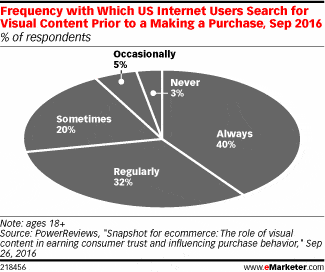
Current adopters of image technologies of all types are pushing the envelope in their fields. Here are eight great examples from across industries and use cases that show how image technology is revolutionizing business. Anyone who wants to compete in these industries will need to adopt image tech or risk falling behind companies that invest in it.
Game-Changing Image Features
Google: Reverse Image Search
Google is a company that has steadily built up their image technologies. There is the regular image search, which they continue to refine, and the reverse image search, which debuted in 2011. It’s a clear-cut tool that is a great example of where image technology is improving.
To use reverse image search on Google, a user simply uploads a photo and then gets returns of similar images. Google has also recently added a feature that brings up related content, links, and information about the photos. For example, it recognizes this image as an Irish landscape and provides web content as well as images in its search return:
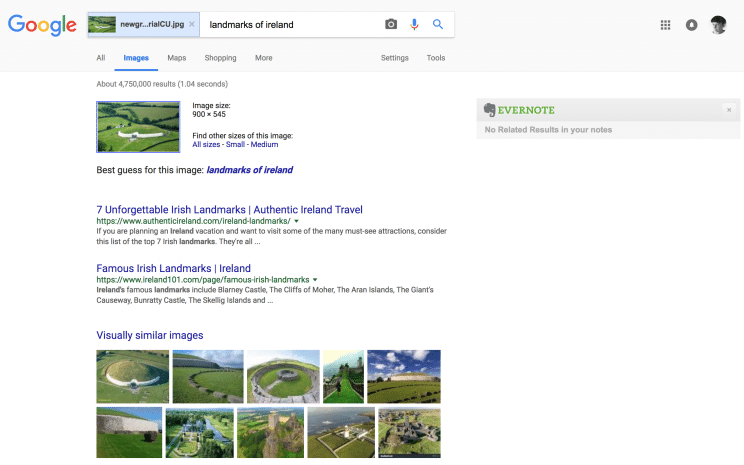
The original function of reverse image search helped people find attributions and get similar pictures in different sizes or resolutions, and it helped browsers quickly find content people enjoyed. This new development taps into where image recognition can really benefit users.
If a user uploads a delicious meal and gets a recipe, or a hairstyle and gets video tutorial, Google allows people to search for content in a more authentic way. Typing “twisty braid updo bun topknot tutorial” will always be harder than uploading an image, and if Google can get accurate results for users without making them type guestimation queries, users will keep coming back for more.
Shutterstock: Image Composition AI
Shutterstock’s AI allows you to search images with words in a novel way. Instead of typing terms that describe an image you want to find (“wine and cheese on table”), you can place those terms in relation to each other in the same way the items would appear in the photo, like so:

This is an interesting way to bridge the word/image divide. It gives people a chance to use both visuals and words to express what they want if they don’t have an image similar to what they’re looking for, but they know exactly what they’re looking for. Customers “create” the image they want to see using compositional elements to find that perfect photo.
This is particularly important for Shutterstock because they are a stock photo service. People who use stock photos often have specific image-composition needs and must have certain elements or certain layouts in their photos. Shutterstock could have used a more traditional reverse image search, but they chose to develop an image recognition tool that responds to the specific needs of their customer.
Boohoo: Visual Search
Boohoo is an online retailer with a huge inventory. To help customers find what they want, the company has implemented an image search. A shopper can upload a picture of an item with the style they’re looking for and immediately see what Boohoo has available that fits their desires.
This is a huge help to users who might otherwise have a hard time sifting through the results on the site. For example, Boohoo currently has 27 pages of little black dresses. Even if you narrow down to “maxi dress,” Boohoo indexes 220 results.

Sorting through Boohoo’s inventory with Syte’s image search was well-received by U.K. shoppers. E-commerce director Andrew Thomson said that the retailer has seen a positive impact on purchase behavior for those who use the tool and that the company plans to expand their feature across their U.S. site soon.
When it comes to navigation, companies need to make sure that their website visitors can get where they want to go with as little hassle as possible. For some, that might be a huge button for a product demo on the main page. When you have tens of thousands of items to index for shoppers, use image search.
Sephora: Virtual Try-On
Sephora’s app uses image technology to help people “try on” different makeup items and looks. It’s a form of facial recognition that stems from early-days “try on” tech, where you uploaded a photo and worked with preset colors and styles. This technology used to be clunky, manual “changes” to your appearance that didn’t accurately reflect what different hairstyles, makeup, and hair colors looked like on consumers.
Now, Sephora and other makeup brands have leapt light years ahead. In Sephora’s app today, you get a very realistic idea of what different products and styles look like on you:
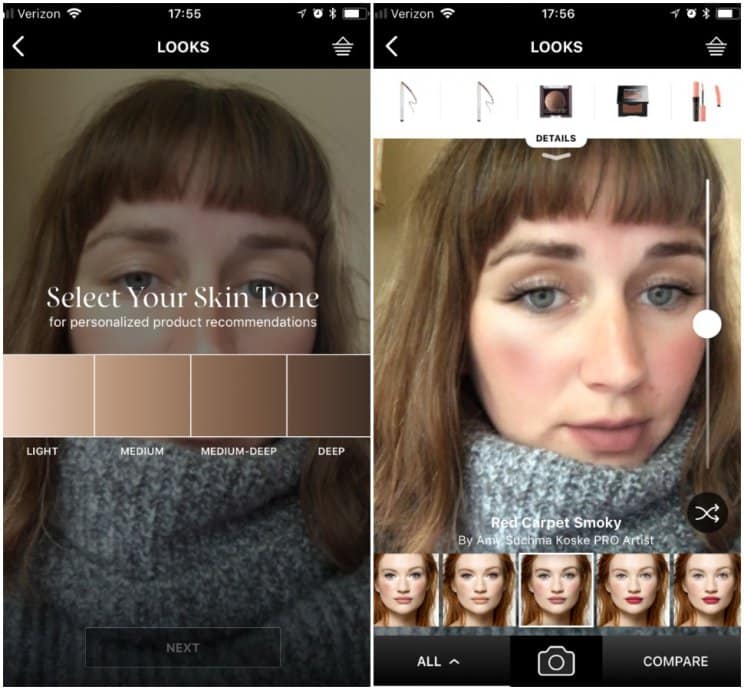
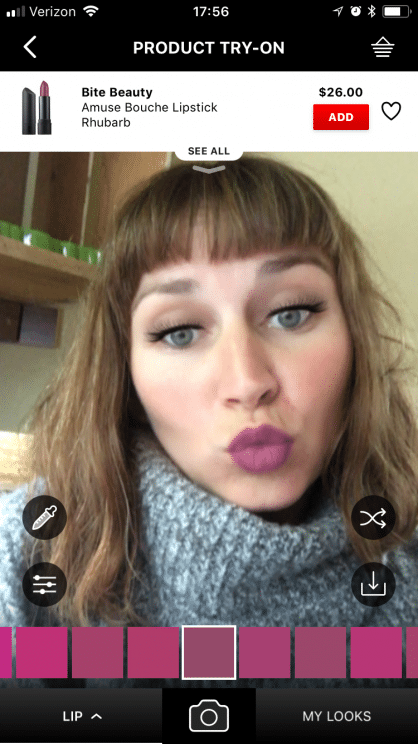
Giving consumers information they need to make a purchase is the name of the game here.
Ebay: Visual Search
Product indexing on user-generated listings is hard. Inconsistent or incomplete data from user listings can mean that shoppers on eBay miss items they might be interested or for which they are unable to guess appropriate search terms. Although the site prompts sellers to give as much information as possible, with thousands of items across dozens of categories, discovery based on metadata is unwieldy.
Luckily, eBay has implemented visual search for their inventory, allowing shoppers to bypass the unpredictability of search.
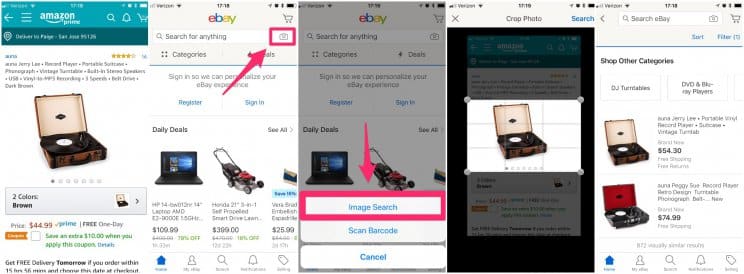
Shoppers can search images on other websites from a desktop, and on eBay’s mobile app as well. Since eBay is a resale site, using images of items you want to find at a discount is a natural way to search.
This is a good move for eBay because they are thinking smart about the way their customers shop. Notice they also have a scan-barcode option on mobile — because they know that shoppers may be trying to find an exact version of an item they like at a discounted price or are trying to find exact items that are luxury, vintage, or rare. They’ve developed tools that cater to the core of their business ethos, which is why they work so well.
Salesforce: Einstein Vision
Einstein Vision is the only software on this list that is a B2B product. But while there are businesses that use image technology internally for a number of purposes, Salesforce’s Einstein Vision is an AI that helps brands navigate their social media better by searching for brand logos and images on social.
While every brand would love that their customers are using brand hashtags or at-mentioning official accounts, the reality is that the majority of consumers aren’t tagging their content that way. So searching the hashtag or looking at a brand’s followers is only capturing a select portion of what a brand’s fans are doing on social.
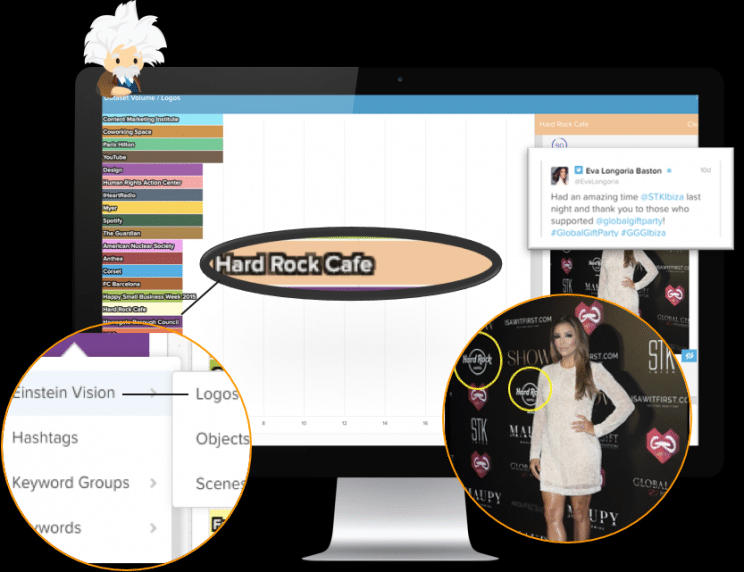
By searching the images themselves, Einstein Vision can help companies drive more authentic user engagement and can help them identify potential influencers. It produces a fuller vision of what types of content are being created with branded material, which will help brands themselves create more authentic content that speaks to their consumers on social.
This product is brilliant because it helps brands better navigate a space that few have conquered. Social media is a minefield of niche content, and short of the rare, much-loved sassy Wendy’s Twitter account, many brands still struggle to engage authentically with their consumers.
Pinterest: Visual Search
It should be no surprise that Pinterest, a platform that’s built almost entirely on images, has developed image recognition software. Pinterest’s visual search lets you choose specific items within a photo to find similar items. For example, a throw pillow on a bed will return more throw pillows:
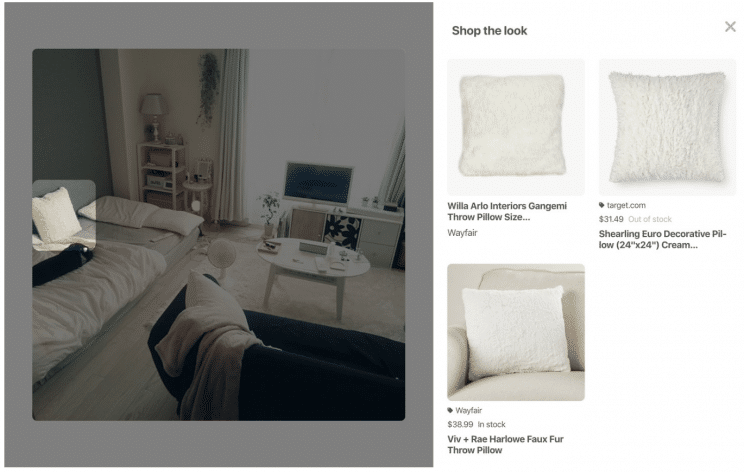
This feature currently has 130 million uses per month, according to the company. And it’s no wonder why.
This is a great move for Pinterest because the platform is well-known for being a great source of inspiration. Would-be interior decorators, wedding planners, prom-goers, costume designers, and anyone else who is keeping track of items they may want to purchase can now do so more easily than ever before. They’ve taken a core use of their product and made it simpler and better for their users.
Learn more about image recognition
If you’re curious about learning more about how these and other image technologies work, check out:
For more about how image recognition is shaping ecommerce, learn about the science behind why humans are hardwired to be visual, and how this drives ecommerce customer success.
And if you’re interested in learning how you can get visual search up on your site in 24 hours, contact Syte today.